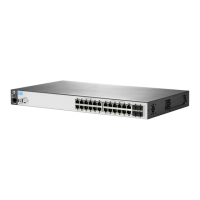Debugging dynamic IP lockdown
To enable debugging of packets dropped by dynamic IP lockdown, enter the debug
dynamic-ip-lockdown command.
Syntax:
debug dynamic-ip-lockdown
To send command output to the active CLI session, enter the debug destination session
command.
Counters for denied packets are displayed in debug security dynamic-iplockdown
command output. Packet counts are updated every five minutes. “The debug dynamic-ip-lockdown
command output” (page 25) shows an example of command output.
When dynamic IP lockdown drops IP packets in VLAN traffic that do not contain a known source
IP-to-MAC address binding for the port where the packets are received, a message is entered in
the event log.
Syntax:
debug destination session
Example 17 The debug dynamic-ip-lockdown command output
HP Switch(config)# debug dynamic-ip-lockdown
DIPLD 01/01/90 00:01:25 : denied ip 192.168.2.100 (0)
(PORT 4) -> 192.168.2.1 (0), 1 packets
DIPLD 01/01/90 00:06:25 : denied ip 192.168.2.100 (0)
(PORT 4) -> 192.168.2.1 (0), 294 packets
DIPLD 01/01/90 00:11:25 : denied ip 192.168.2.100 (0)
(PORT 4) -> 192.168.2.1 (0), 300 packets
DIPLD 01/01/90 00:16:25 : denied ip 192.168.2.100 (0)
(PORT 4) -> 192.168.2.1 (0), 300 packets
DIPLD 01/01/90 00:21:25 : denied ip 192.168.2.100 (0)
(PORT 4) -> 192.168.2.1 (0), 299 packets
DIPLD 01/01/90 00:26:25 : denied ip 192.168.2.100 (0)
(PORT 4) -> 192.168.2.1 (0), 300 packets
DIPLD 01/01/90 00:31:25 : denied ip 192.168.2.100 (0)
(PORT 4) -> 192.168.2.1 (0), 300 packets
DIPLD 01/01/90 00:36:25 : denied ip 192.168.2.100 (0)
(PORT 4) -> 192.168.2.1 (0), 299 packets
DIPLD 01/01/90 00:41:25 : denied ip 192.168.2.100 (0)
(PORT 4) -> 192.168.2.1 (0), 300 packets
Differences between switch platforms
Differences in the feature set and operation of Dynamic IP Lockdown depend on the switch where
it is implemented as listed below.
• There is no restriction on GVRP on 2620, 3500, 3500yl, 5400zl, 6200yl, 6600, and 8200zl
switches.
• “Dynamic IP lockdown host limits” (page 26) shows host limits for dynamic IP Lockdown.
Dynamic IP Lockdown 25

